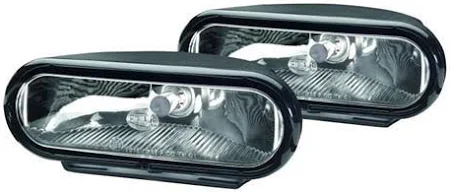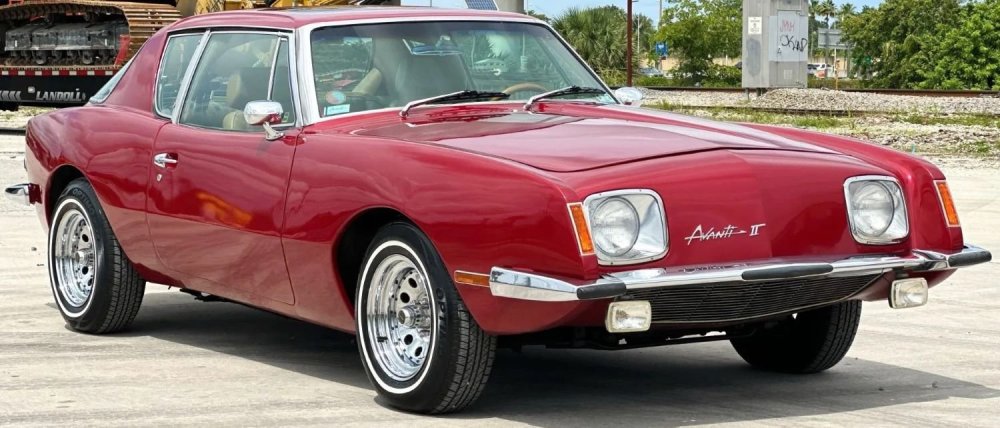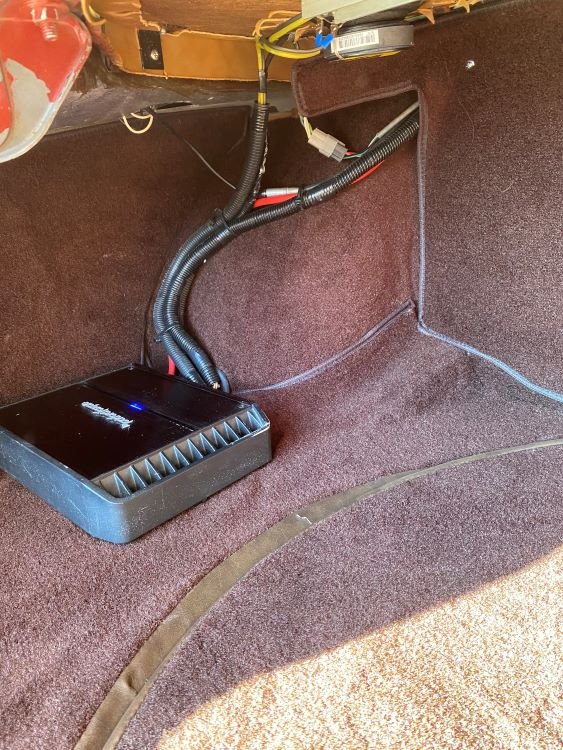-
Posts
97 -
Joined
-
Last visited
Content Type
Profiles
Forums
Events
Everything posted by ronmanfredi
-
desperate help needed for 1971 Avanti II
ronmanfredi replied to Quicksilver's topic in 1965-83 Avanti
350 with a 200R4. If you get a high horsepower 350 then you should get a built 200R4 for it. -
You can remove the power wire from the voltmeter and seal off the end. Then run a new power wire to the fuse box spade terminal that only becomes hot when the key is on.
-
My 82 does not have any removable battery tray and doesn't need one. There is a place for the top battery frame clamp rods to go and that's it.
-
With the 2 regulator arms popped out of the lower window track and the 3 bolts and 2 nuts removed from the ventilator (with the 2 screws turned in) the window should lift right up and out (while tilting the ventilator forward and slightly up). Double check and be sure the regulator arms at the bottom of the window track are popped completely out of the bushings
-
First place I'd check is the ignition switch based on what you said.
-
The cable attaches to the transmission with a speedometer gear, there isn't any additional sensor.
-
-
No, I left the coil spring spacers in place.
-
It's amazing how much time and money it took to bring our 1982 Avanti up to the shape it needed to be in. Purchased in May 2023, I went through the entire car, front to back, mechanical, electrical, Interior and exterior except paint. $9000 in parts and countless hours of labor and she is all but refurbished to where we are happy with her. I did all the work in my home garage, didn't take it to any shop except for the new true dual exhaust and wheels/tires. Shoot, I even bought the turntables, caster camber gauge and Toe Bar to align the front end after rebuilding it. The last thing that I did was to replace the old Fog Lights with some new ones that are now recessed behind the bumper and centered under the headlights. We like it and hope you do too!
-
I had to do some work on mine and the parts were from a 1980 BMW Recaro seat. I have the same interior color as yours but wasn't able to find a supplier of the OEM leather, so I repaired the leather and did a dye on the entire seat. It's close, but you can't match to the color variation of the OEM leather.
-
Yes, the gauge will pull out completely. What I meant was that you can pull it out part way, remove the bulbs and then completely remove it away from the dash. Installing it is in reverse, you'll just need to be sure to level the gauge while tightening the retaining nuts on the clamp. The clamp design will allow you to rotate the gauge into most any position.
-
The cable is held on by a threaded collar (round nut). You just unscrew it a few turns and then the nut will slide down the cable. You can pull the cable out of the speedo head at that time. More than likely, you can pull the speedo out enough to get the light bulbs out as well.
-
I added an electric fan to my 82 model stock radiator also. Had the radiator cleaned, it was in really good shape so I kept it. The fan is a 15" and includes a correctly designed shroud that covers 90% of the core. It has a variable speed controller that ramps up to maximum speed and turns on when the A/C compressor is running. Due to the amperage that the fan draws at top speed, I went ahead and replaced the 70 amp alternator with a 135 amp. Everything is working as it should !
-
There are 2 different bulbs used in the gauges and the base size is the difference. You'll need to get the correct bulb in order for it to stay in the holder.
-
You need a pair of long needle nose pliers and a long thin screw driver to help you remove, place and pop the bulb holders back into the gauges. You can remove the tach and speedo also, which will help you with the smaller gauges. I did all of them on my back, with the front seat out but I had to disconnect and push the speedo cable out of the way also. Be sure you disconnect the car battery while doing this also.
-
All the bulbs go into the gauges from the back. I replaced many of mine and some a quite a challenge, especially the ones at the top of the gauges. I had the drivers seat out which allowed me to lay on my back the entire time. Some will tell you its easier to remove the Tach to provide easier access to some of the bulbs. The vacuum gauge bulb can be reached through the dash speaker/cup holder hole also.
-
some thoughts/advice would be appreciated
ronmanfredi replied to Quicksilver's topic in 1965-83 Avanti
I would continue on your journey to build your 71. If you retain your stock front suspension, then I recommend rebuilding it and increasing the caster by adding shims to the upper and lower control arms. I did that and wrote a post about it on this forum and it made a world of difference in steering and handling. While a LS is really nice, you could save money by installing a strongly built 350, just a thought. -
Nice repair on the switch wiring !
-
You may be right and we will see. I think the prep is really important. I also put a lot of pressure on the repaired areas after fixing them to see if any separation occurred. In a couple of places they did, so I went back and removed more of the area affected. Time will tell !
-
Remove the door panel. Remove the protective paper from all holes in the door. Take a marker or scribe and mark the location of every nut and bolt possible so that you can put the bolts/nuts back where they were. Most of these are in slotted holes. Lower the window all the way. Remove the 2 large and 1 small bolts under the vent window area and the 2 nuts holding the vent window /channel track assembly at the front of the door. Turn the 2 adjusters that had nuts on them clockwise until the clear the holes they are in. Count the turns. Mine were 10 turns at the top and 5 turns on the bottom. The vent window will now be loose and can be moved around in the door. Next, remove the 2 C Clips off of the window frame lower rollers and pop the 2 arms out of the lower glass frame rollers. These clips are on the rollers between the arms and glass frame. Now you can slide the glass out while tilting the vent window frame forward. Take a flashlight and look into the door and study how everything is mounted, just so you are familiar with how it looks before removing the regulator assembly. Now, raise the window frame up close to the top of the door using the motor. This lowers the spring pressure at the motor once the assembly is out. Locate the electrical connection at the front lower part of the door and disconnect the motor. Push the plug inside the door. There may be a clip holding the motor wiring harness in place and you'll need to unclip the harness from the door. You can now remove the regulator assembly. There are 4 bolts holding the regulator in a square pattern, 3 bolts holding the arm bell crank in a triangle pattern and 2 bolts holding the horizonal guide (towards the rear side of the door). Once these are removed, the regulator with electric motor can be removed through the large opening at the bottom of the door. Note that the triangular mount on the bell crank can only mount on the door one way, it is not symmetrical. Reassembly is the reverse of this. This is a good time to clean and lube all of the tracks and rollers. Good Luck!
-
I recently decided to attempt to repair the leather on our 82 Avanti seats and upper door panels. Parts of the interior had been redyed to fill in the cracks by the previous owner, but it wasn’t a successful repair. I did contact a couple of seat cover companies, but they couldn’t match the upholstery that was in the car. I found an online company called Seat Doctor who sells a leather crack filler and they can make custom dyes to match your existing leather. I cut off a piece on the back side of a door panel and mailed it too them to match. The OEM leather has color variations in it, so I knew a solid color dye would look different. With the seats and door panels out, I began to work on the various cracks and damaged areas. I learned that it was best to cut out any crack edge that was flaking up using some sharp flush cut wire cutters and/or a Dremel tool with a coarse sanding drum on it. Once the rough edges were all gone, then I used 400 grit sand paper to smooth out the edges and roughen up the leather. Next, I applied the crack filler and leveled it out. In some cases, it took more than one coat to achieve the desired results. The last task is to do a finish sand with 600 grit paper. Like a car body, the prep work really makes a difference on the repair. The leather does flex when you are working with it, so you have to take your time to get the finish where you want it. The leather crack filler does have a lot of flex in it when dry, which is good. The dye is a water-based product that does not need thinning. You can use a variety of methods to apply it, I chose a $28 mini HLVP paint gun from Harbor Freight. The seller recommends putting on a couple of coats 30 minutes apart, with a fully cure time of 48 hours. With this in mind, I dyed the back side or underneath of the seat sections and then let them sit for 2 days. Then I dyed the Front or Upper side of the seat cushion and let them sit for an additional 2 days as well. Once the dye had cured, I reassembled the seats and installed them and the door panels. Note: While learning how to do this, I did use the Dye as a 1 coat primer to visually see how the initial repair would look on each part, which was either good or it prompted me to do more work on certain areas. Enjoy the photos!
-
https://aoai.org/forums/topic/43653-leaking-sunroof-repair/ Read the info in the link above
-
On my 82 model, the original gauge doesn't have any resistor on it and it dead on with the stock sensor. It may be that the old style gauge like he is showing are the ones with problems.
-
Do you have a thermostat in the engine and if so, is it working?
-
Our 1982 Avanti came with the Blaupunkt CR-3001 Cassette Radio, which includes a 15-watt amplifier that is mounted on top of the radio, under the dash cup holder. All 4 speakers were worn out, so I replaced them with JL Audio 4” on the front and 6.5” on the rear deck. Once done, I could tell the output of the 15-watt amp didn’t have enough power for the new speakers, so I decided to install a 50 watt per channel Rockford Fosgate amp that I had from a previous vehicle. Due to the size of the amp, I decided to mount it in the trunk and ran the power lead and front speaker in-out wires to it. The rear speaker “in” wires to the amp were right above it’s location, so it was easy to wire them up. Both the radio and 15-watt amp can be removed through the dash cup holder hole. The next challenge was to figure out how to connect to the radio’s DIN plug. After doing some research, I located a basic 7 pin Din plug “pin out” image and modified it to represent the radio harness Din connector, using a volt meter. Next, I purchased a high quality 7 pin DIN connector so I could make up a harness to connect to the radio and wires going to the new amp. To make the new harness, you need 20–22-gauge wire, a good quality small round tip solder gun, some flux and solder. I had some old 22-gauge speaker wire that I used, marking each one for what they were for. In reference with the attached image, #7 Pin 12-volt DC Pin is for your amp’s turn on signal wire. #2 is the ground for ALL 4 of your speakers. The other pins are for each speaker + connection, #6 is not used. Once I had the DIN connector harness made, and before I reinstalled the radio, I connected everything to the radio and tested it out. All speakers were working, but the volume was really weak. Then I remembered the radio speaker output voltage was less than 1 volt, where most modern radios are 4-6 volts. So, I went to the amp and turned up the gains to right at ¾ full and now the speakers were working fantastic. If you want to get the rid of the heavy, weak 15-watt amp sitting on top of your Blaupunkt CR-3001 radio and install a modern amp of your choice, you now know how to do it!






